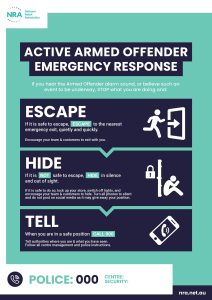Active Armed Offender Incidents
What is an active armed offender incident?
An active armed offender incident may involve a person or persons attacking people at random in a crowded public place to cause as much harm or fear as possible within a short period of time. If it does occur, an average active armed offender incident lasts for only 12 minutes.
Active armed offenders are not just ‘terrorists’ and may include intoxicated or mentally impaired individuals. They may use a variety of weapons including guns, knives, syringes, chemicals, vehicles or improvised weapons. They may be highly organised or unpredictable. They may be a group or solo. They may have affiliations or none at all.
The occurrence of an active armed offender event is rare, unexpected and generally, most people’s immediate response is to freeze and then try to find a normal explanation for what they are hearing or seeing. For example, witnesses describe comments like “they must be making a movie” or “it’s fireworks”. This confusion wastes valuable time which may be used to move to safety.
Knowing what to do and where to go, can help you take action rapidly, which may save lives and prevent injuries.
** Active armed offenders are there to hurt people. They are not interested in products or cash.
Offenders can evolve generally from incidents. For example, a customer who originally arrived in the store to discuss their goods return and received an unwanted response from the team. This could trigger a mental health response associated with other events that may have occurred in their life in recent times or historically. They may escalate their aggression rapidly through no direct fault of any individual, picking up anything nearby to them that could be used as a weapon and thereby creating an active armed offender incident. In retail this could be scissors, signage poles, liquid (hot water/drink).
Recommended response
The Australian New Zealand Counter Terrorism Committee response for an active armed offender event underway is to:
- ESCAPE – run to safety, if you can do so safely
- HIDE – if you can’t escape safely
- TELL – report it as soon as it’s safe to do so
Download poster for your store >
Training
Do you know what to do if an active armed offender came into your business with the sole intention of hurting people? Like any emergency, you should have a well-practiced plan for what to do.
The National Retail Association is has developed training to help retailers prepare, survive and recover from active armed offender incidents. Contact us at policy@nra.net.au for more information.
Have you got an escape plan?
Under the Australian Standard AS 3745:2010 Planning for emergencies in facilities, your escape plan must meet minimum requirements.
The National Retail Association has created a basic template for an escape plan adapted from the standard fire evacuation plan issued by local authorities. If you are not familiar with the Word doc format, you can print it off the PDF version and draw out your floorplan.
DOWNLOAD ESCAPE PLAN TEMPLATE (docx) DOWNLOAD ESCAPE PLAN TEMPLATE (PDF)
Essential requirements:
The plan must show the following items as a minimum:
- A pictorial representation of the floor area – insert a diagram from shapes to represent the floor space.
- YOU ARE HERE location. This would show the location of the escape plan in your business. Cut and paste, or drag the icon to the location on your floor plan.
- Emergency exits and any alternative means of exit such as windows and doors to other areas. Make sure you use the icons correctly.
- Paths of travel from the escape plan to all the points of exit. The icons can be copied and lengthened for additional lines.
- Meeting point for your staff. This should be different from the emergency assembly point. If you have room, you can show this on your diagram, otherwise write the address/ location.
- Hiding places/refuge.
- Location of your store, including address postcode; access street and nearest cross street.
- Validity date [plans are valid for a maximum of 5 years].
Your escape plan diagram must be A4 size if your floor space is up to 3m x 2m / 6m sq. If over this size it should be A3 size. The diagram must be oriented to show the correct direction of exit in relation to the position of the diagram and the “YOU ARE HERE” icon.
The escape plan must be placed on the wall with the bottom edge at least 120cm from the floor, and the top edge no higher than 160cms from the floor.
Links to more information
Tenants and Landlords have the primary responsibility for protecting their sites, including a duty of care to take steps to protect people that work, use, or visit their site from a range of foreseeable threats, including terrorism.
External Useful links:
Persons concerned in the management of crowded places should review the updated Strategy visiting
Australia’s Strategy for Protecting Crowded Places from Terrorism:
Australia’s Strategy for Protecting Crowded Places from Terrorism 2023 (nationalsecurity.gov.au)
Acting Armed Offender (AAO) Guidelines:
Escape.Hide.Tell
www.nationalsecurity.gov.au/what-can-i-do/what-to-do-in-an-attack
Contact our team
Retailers have a wide range of pressures and obligations in terms of providing best practice information and resources to keep their teams safe and prepared. The National Retail Association offers training and assistance in preparing teams for serious incidents or emergency events such as managing an active armed offender, dealing with aggressive behaviour or reporting suspicious activity. Contact us for more information.

David Stout

Bonnie Marshall

Lily Charlton

Alysha Rowley
Alysha has completed a double degree in business and international relations with a broad skill set gained from both coursework and industry experience. Alysha’s career interests are also driven by her passion for helping others and making the community a safer, happier place. This fuels her ambition to make a difference and add value to whatever she does in an enthusiastic and meaningful way.
